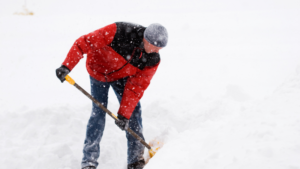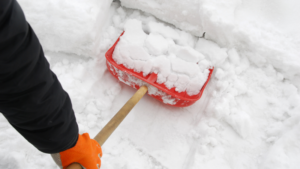Whether you’re excited about the prospect or not, winter is on its way. It’s time to pull out the shovels, tune up the snowblower, and get ready to greet that old friend that accompanies the arrival of every Minnesota winter — snow.
Keep your driveways and walkways clear and safe this winter with these tips for snow and ice removal.
Before the Snow Flies, Mark Driveways and Walkways With Tall Stakes
Marking the boundaries of your driveways and walkways is helpful whether you shovel or use a snowblower, and especially if you hire out your snow and ice removal. Once a thick layer of snow covers the landscape, it can be difficult to see where your sidewalk or driveway ends and your lawn begins. Using tall stakes to mark these areas will help you stay on the pavement when removing snow and ice from your property.
Invest in Quality Equipment and Keep It Maintained
When you live in a place like Minnesota that gets a lot of snow, it’s important to invest in good quality snow removal equipment. Spending a little more money on a high-quality shovel or snowblower means you won’t need to buy replacements as often and you’ll have an easier time removing snow from your property.
Not sure how to determine if the equipment you’re looking at is quality? Take a look at online reviews for snow shovels and snowblowers to help you narrow down your options.
If you use a snowblower, take the time to do a little preventive maintenance now to make sure your machine is ready for the first snowfall. Do a thorough inspection to ensure all parts are in working order, and replace or repair any parts that need it. Change the oil and fill up the gas tank as well.
Safety First

Shoveling, especially when the snow is wet and heavy, can be hard on your body. To avoid injury:
- Lift with your legs, keeping the blade of the shovel close to your body as you lift it.
- Regularly switch between shoveling with your left and right hands, and switch your grip between overhand and underhand to avoid overstraining one side.
- Keep your back straight, and avoid twisting from side to side.
While using a snowblower can be a bit easier on the back, it can still cause injury if you aren’t careful. When snow blowing:
- Always keep shields in their proper place.
- Keep the chute pointed away from people, vehicles, and buildings.
- Keep hands and feet away from moving mechanisms.
- Watch for items in your path. If an object gets churned into the snowblower, it could not only cause damage to the machine, but it could also get tossed into the air, potentially causing injury.
Remove Snow Incrementally
The best way to tackle snow removal is in stages. Ideally, you should head out to shovel or snow blow periodically throughout a snowstorm. If you keep up on it, you can avoid having to move big quantities of snow at once.
If you do wait until after a storm, work to remove snow a little at a time. Shovel the top few inches off first, then work your way down to the pavement. Avoid filling your shovel too heavily with snow — shovel only as much snow as you feel comfortable lifting.
Take Breaks
Take regular breaks during the snow removal process, both to rest your back and arms and to warm up indoors. Go inside to sit down and enjoy a cup of cocoa before heading back out again. Frequent breaks are key to avoiding injury or excessive exhaustion.
Watch Where You Pile Your Snow

Watch where you’re tossing snow so you don’t end up shoveling the same snow twice. Don’t pile snow right along the edge of your driveway or sidewalk, where it can fall back down onto the pavement. Instead, haul each shovelful of snow away from the area you’re clearing.
In addition, don’t pile snow near your home’s foundation — moisture from melting snow can seep in, leading to a wet basement and potentially damaging your foundation. While snow does have insulating properties, when it’s up against your home it loses much of its insulating power, and can end up damaging your home (much like ice dams can cause damage to your roof).
Choose Ice Melt Wisely
There are a number of different products you can use to keep your driveways and walkways from becoming slippery, ranging from rock salt and calcium chloride to sand, ashes, and urea.
Some of these options are safer than others. Rock salt, for instance, can be toxic to plants and pets alike in larger quantities, so it should be used carefully. Sand, on the other hand, is harmless (though it doesn’t dissolve like salt will, so you’ll need to clean it up).
No matter which substance you choose to use, all of them are most effective once you’ve removed the snow from paved surfaces. After you’ve cleared an area of snow, sprinkle on your ice melt of choice to keep surfaces from becoming slippery.
Leave Your Snow and Ice Removal to McDonough
While all of these practices will help make your snow and ice removal safer and more effective, an even better option is to leave the work to the pros.
If you like the idea of never having to shovel or snow blow your driveway or walkways again, McDonough Landscaping can help make that dream a reality. For those in the Woodbury area, we offer snow removal services, including:
- Plowing your driveway
- Clearing your walkways
- Salting and sanding icy areas
- Moving excess snow safely and evenly
If you live in the Woodbury area and would like to take advantage of our snow removal services this winter, reach out to us today to get on our schedule.

